Critical Review: Patients' Experience of COPD Exacerbations
VerifiedAdded on 2021/05/31
|14
|3618
|73
Report
AI Summary
This report presents a critical review of a qualitative study focusing on patients' experiences with identifying and managing exacerbations in Chronic Obstructive Pulmonary Disease (COPD). The study, conducted by Williams (2014), explores patients' understanding of COPD exacerbations, their ability to recognize deteriorating features, and their self-management strategies. The review examines the study's background, including the significance of the research in reducing hospital re-admissions and improving patient outcomes. It analyzes the research design, aims, and the use of a qualitative approach. The report also evaluates the sampling techniques, including inclusion and exclusion criteria, and assesses the appropriateness of the chosen purposive sampling method. Furthermore, the review discusses the data collection methods, specifically semi-structured interviews, and evaluates their advantages and disadvantages, as well as alternative methods. The analysis section details how the data was analyzed using grounded theory and comparative methods. Overall, the report critically assesses the study's methodology, findings, and implications for healthcare, providing a comprehensive overview of the research process and its contribution to the understanding of COPD exacerbations.
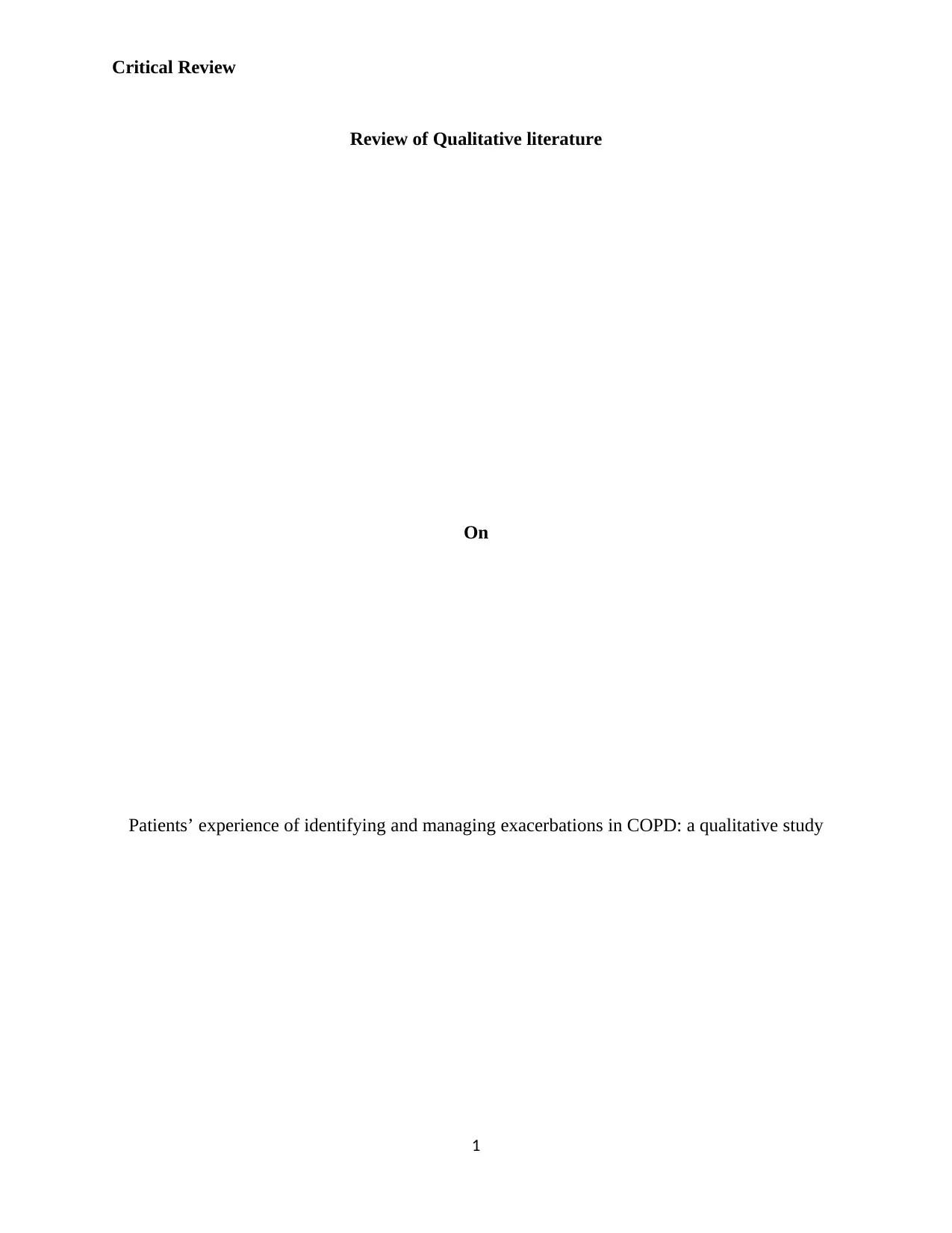
Critical Review
Review of Qualitative literature
On
Patients’ experience of identifying and managing exacerbations in COPD: a qualitative study
1
Review of Qualitative literature
On
Patients’ experience of identifying and managing exacerbations in COPD: a qualitative study
1
Paraphrase This Document
Need a fresh take? Get an instant paraphrase of this document with our AI Paraphraser
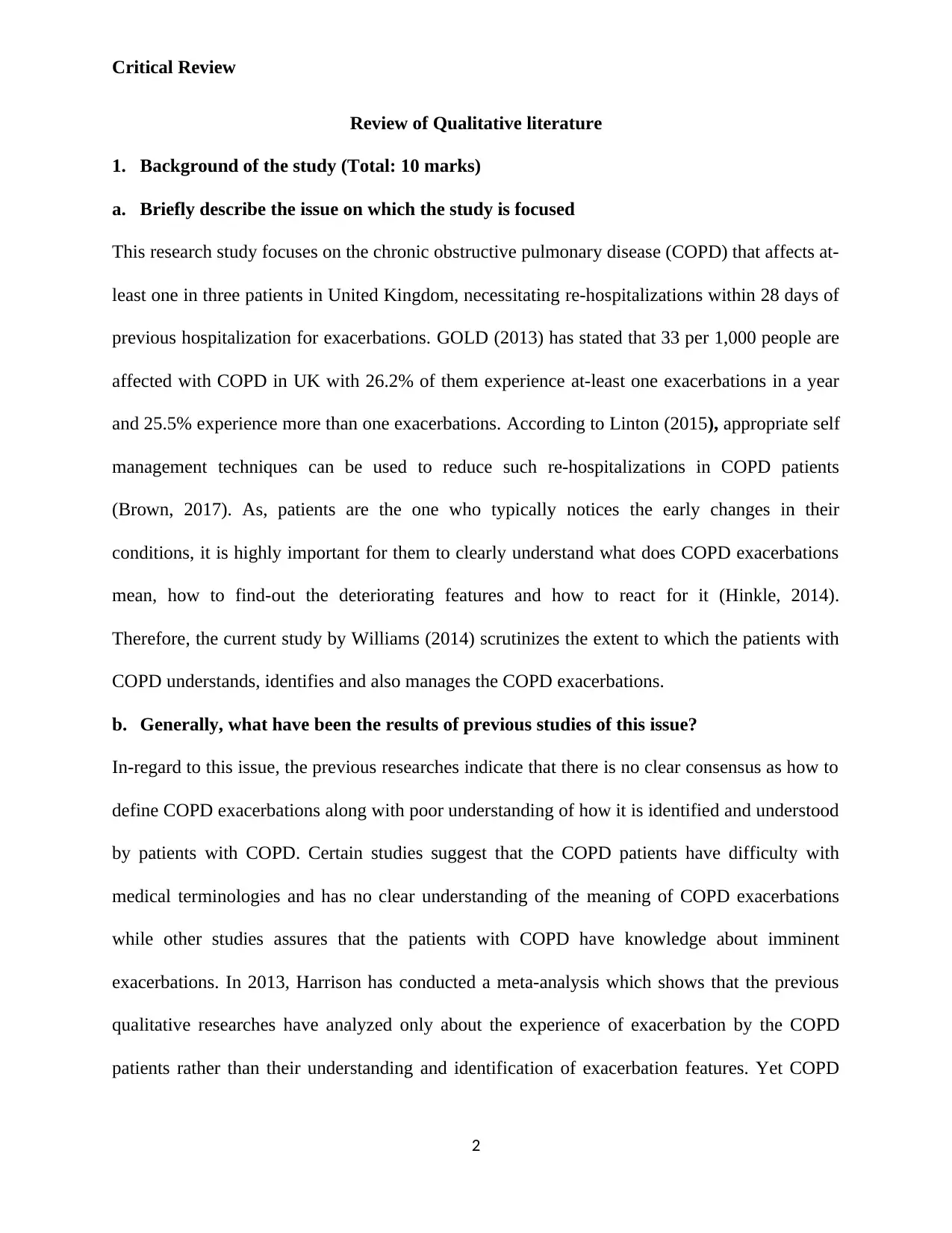
Critical Review
Review of Qualitative literature
1. Background of the study (Total: 10 marks)
a. Briefly describe the issue on which the study is focused
This research study focuses on the chronic obstructive pulmonary disease (COPD) that affects at-
least one in three patients in United Kingdom, necessitating re-hospitalizations within 28 days of
previous hospitalization for exacerbations. GOLD (2013) has stated that 33 per 1,000 people are
affected with COPD in UK with 26.2% of them experience at-least one exacerbations in a year
and 25.5% experience more than one exacerbations. According to Linton (2015), appropriate self
management techniques can be used to reduce such re-hospitalizations in COPD patients
(Brown, 2017). As, patients are the one who typically notices the early changes in their
conditions, it is highly important for them to clearly understand what does COPD exacerbations
mean, how to find-out the deteriorating features and how to react for it (Hinkle, 2014).
Therefore, the current study by Williams (2014) scrutinizes the extent to which the patients with
COPD understands, identifies and also manages the COPD exacerbations.
b. Generally, what have been the results of previous studies of this issue?
In-regard to this issue, the previous researches indicate that there is no clear consensus as how to
define COPD exacerbations along with poor understanding of how it is identified and understood
by patients with COPD. Certain studies suggest that the COPD patients have difficulty with
medical terminologies and has no clear understanding of the meaning of COPD exacerbations
while other studies assures that the patients with COPD have knowledge about imminent
exacerbations. In 2013, Harrison has conducted a meta-analysis which shows that the previous
qualitative researches have analyzed only about the experience of exacerbation by the COPD
patients rather than their understanding and identification of exacerbation features. Yet COPD
2
Review of Qualitative literature
1. Background of the study (Total: 10 marks)
a. Briefly describe the issue on which the study is focused
This research study focuses on the chronic obstructive pulmonary disease (COPD) that affects at-
least one in three patients in United Kingdom, necessitating re-hospitalizations within 28 days of
previous hospitalization for exacerbations. GOLD (2013) has stated that 33 per 1,000 people are
affected with COPD in UK with 26.2% of them experience at-least one exacerbations in a year
and 25.5% experience more than one exacerbations. According to Linton (2015), appropriate self
management techniques can be used to reduce such re-hospitalizations in COPD patients
(Brown, 2017). As, patients are the one who typically notices the early changes in their
conditions, it is highly important for them to clearly understand what does COPD exacerbations
mean, how to find-out the deteriorating features and how to react for it (Hinkle, 2014).
Therefore, the current study by Williams (2014) scrutinizes the extent to which the patients with
COPD understands, identifies and also manages the COPD exacerbations.
b. Generally, what have been the results of previous studies of this issue?
In-regard to this issue, the previous researches indicate that there is no clear consensus as how to
define COPD exacerbations along with poor understanding of how it is identified and understood
by patients with COPD. Certain studies suggest that the COPD patients have difficulty with
medical terminologies and has no clear understanding of the meaning of COPD exacerbations
while other studies assures that the patients with COPD have knowledge about imminent
exacerbations. In 2013, Harrison has conducted a meta-analysis which shows that the previous
qualitative researches have analyzed only about the experience of exacerbation by the COPD
patients rather than their understanding and identification of exacerbation features. Yet COPD
2
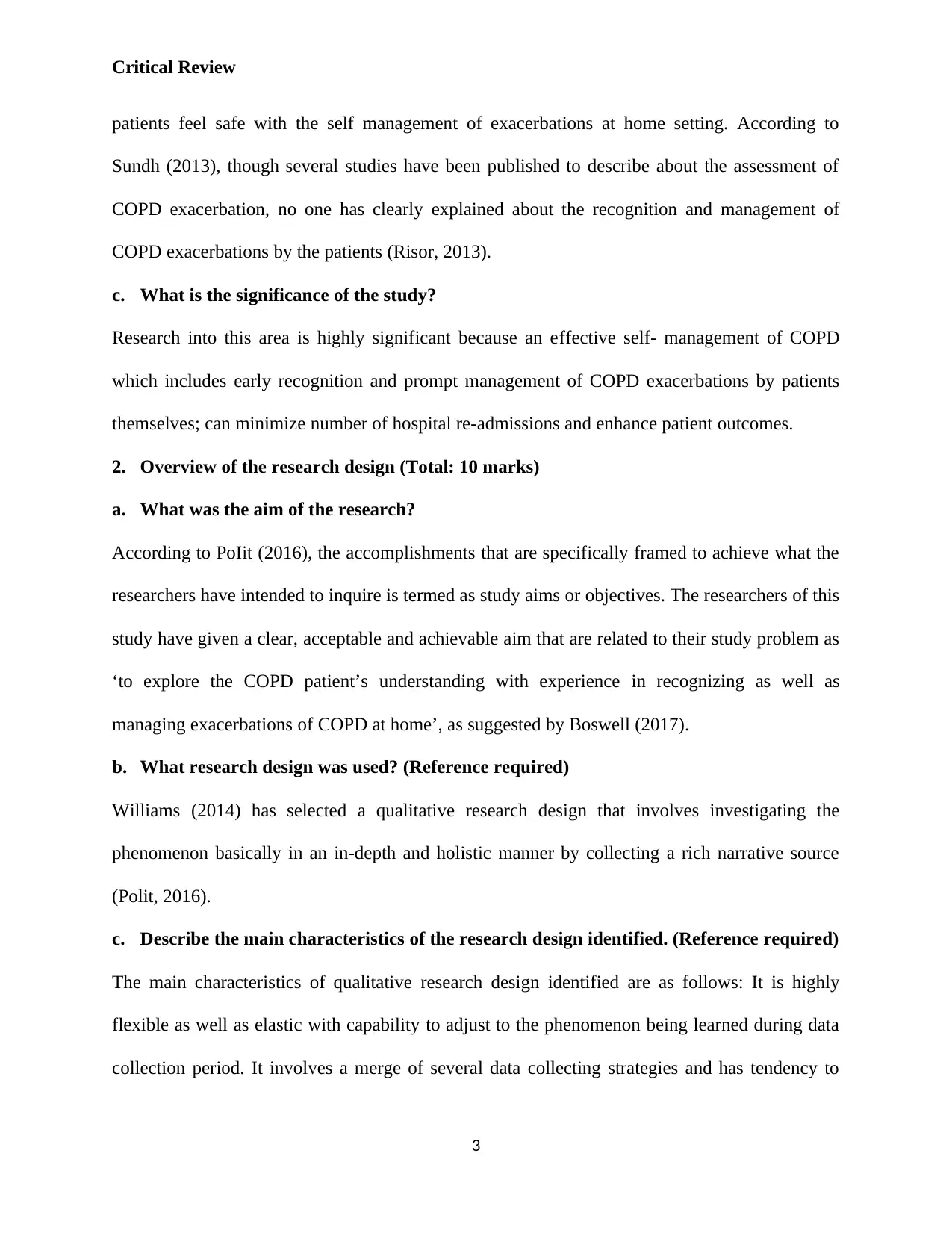
Critical Review
patients feel safe with the self management of exacerbations at home setting. According to
Sundh (2013), though several studies have been published to describe about the assessment of
COPD exacerbation, no one has clearly explained about the recognition and management of
COPD exacerbations by the patients (Risor, 2013).
c. What is the significance of the study?
Research into this area is highly significant because an effective self- management of COPD
which includes early recognition and prompt management of COPD exacerbations by patients
themselves; can minimize number of hospital re-admissions and enhance patient outcomes.
2. Overview of the research design (Total: 10 marks)
a. What was the aim of the research?
According to PoIit (2016), the accomplishments that are specifically framed to achieve what the
researchers have intended to inquire is termed as study aims or objectives. The researchers of this
study have given a clear, acceptable and achievable aim that are related to their study problem as
‘to explore the COPD patient’s understanding with experience in recognizing as well as
managing exacerbations of COPD at home’, as suggested by Boswell (2017).
b. What research design was used? (Reference required)
Williams (2014) has selected a qualitative research design that involves investigating the
phenomenon basically in an in-depth and holistic manner by collecting a rich narrative source
(Polit, 2016).
c. Describe the main characteristics of the research design identified. (Reference required)
The main characteristics of qualitative research design identified are as follows: It is highly
flexible as well as elastic with capability to adjust to the phenomenon being learned during data
collection period. It involves a merge of several data collecting strategies and has tendency to
3
patients feel safe with the self management of exacerbations at home setting. According to
Sundh (2013), though several studies have been published to describe about the assessment of
COPD exacerbation, no one has clearly explained about the recognition and management of
COPD exacerbations by the patients (Risor, 2013).
c. What is the significance of the study?
Research into this area is highly significant because an effective self- management of COPD
which includes early recognition and prompt management of COPD exacerbations by patients
themselves; can minimize number of hospital re-admissions and enhance patient outcomes.
2. Overview of the research design (Total: 10 marks)
a. What was the aim of the research?
According to PoIit (2016), the accomplishments that are specifically framed to achieve what the
researchers have intended to inquire is termed as study aims or objectives. The researchers of this
study have given a clear, acceptable and achievable aim that are related to their study problem as
‘to explore the COPD patient’s understanding with experience in recognizing as well as
managing exacerbations of COPD at home’, as suggested by Boswell (2017).
b. What research design was used? (Reference required)
Williams (2014) has selected a qualitative research design that involves investigating the
phenomenon basically in an in-depth and holistic manner by collecting a rich narrative source
(Polit, 2016).
c. Describe the main characteristics of the research design identified. (Reference required)
The main characteristics of qualitative research design identified are as follows: It is highly
flexible as well as elastic with capability to adjust to the phenomenon being learned during data
collection period. It involves a merge of several data collecting strategies and has tendency to
3
⊘ This is a preview!⊘
Do you want full access?
Subscribe today to unlock all pages.

Trusted by 1+ million students worldwide
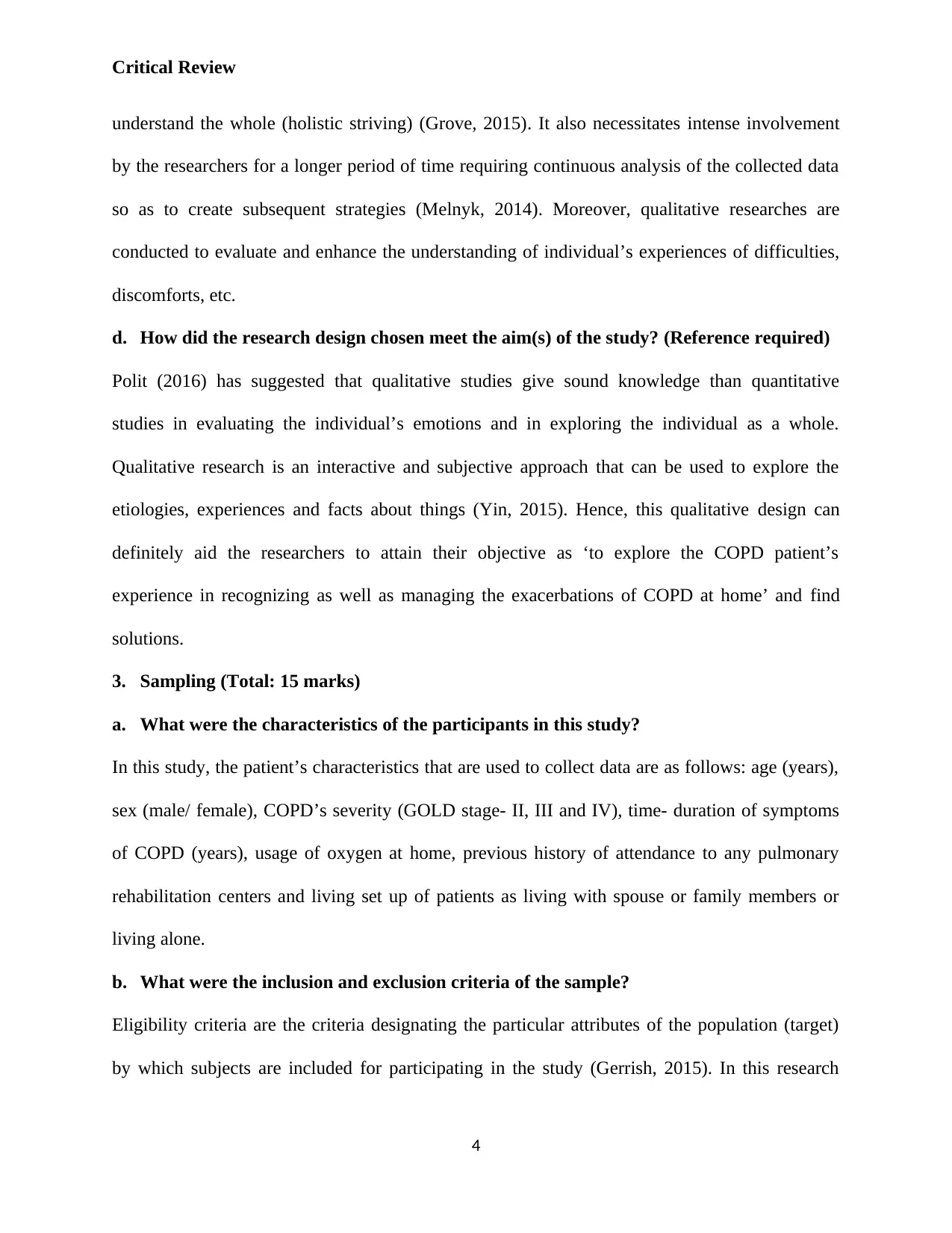
Critical Review
understand the whole (holistic striving) (Grove, 2015). It also necessitates intense involvement
by the researchers for a longer period of time requiring continuous analysis of the collected data
so as to create subsequent strategies (Melnyk, 2014). Moreover, qualitative researches are
conducted to evaluate and enhance the understanding of individual’s experiences of difficulties,
discomforts, etc.
d. How did the research design chosen meet the aim(s) of the study? (Reference required)
Polit (2016) has suggested that qualitative studies give sound knowledge than quantitative
studies in evaluating the individual’s emotions and in exploring the individual as a whole.
Qualitative research is an interactive and subjective approach that can be used to explore the
etiologies, experiences and facts about things (Yin, 2015). Hence, this qualitative design can
definitely aid the researchers to attain their objective as ‘to explore the COPD patient’s
experience in recognizing as well as managing the exacerbations of COPD at home’ and find
solutions.
3. Sampling (Total: 15 marks)
a. What were the characteristics of the participants in this study?
In this study, the patient’s characteristics that are used to collect data are as follows: age (years),
sex (male/ female), COPD’s severity (GOLD stage- II, III and IV), time- duration of symptoms
of COPD (years), usage of oxygen at home, previous history of attendance to any pulmonary
rehabilitation centers and living set up of patients as living with spouse or family members or
living alone.
b. What were the inclusion and exclusion criteria of the sample?
Eligibility criteria are the criteria designating the particular attributes of the population (target)
by which subjects are included for participating in the study (Gerrish, 2015). In this research
4
understand the whole (holistic striving) (Grove, 2015). It also necessitates intense involvement
by the researchers for a longer period of time requiring continuous analysis of the collected data
so as to create subsequent strategies (Melnyk, 2014). Moreover, qualitative researches are
conducted to evaluate and enhance the understanding of individual’s experiences of difficulties,
discomforts, etc.
d. How did the research design chosen meet the aim(s) of the study? (Reference required)
Polit (2016) has suggested that qualitative studies give sound knowledge than quantitative
studies in evaluating the individual’s emotions and in exploring the individual as a whole.
Qualitative research is an interactive and subjective approach that can be used to explore the
etiologies, experiences and facts about things (Yin, 2015). Hence, this qualitative design can
definitely aid the researchers to attain their objective as ‘to explore the COPD patient’s
experience in recognizing as well as managing the exacerbations of COPD at home’ and find
solutions.
3. Sampling (Total: 15 marks)
a. What were the characteristics of the participants in this study?
In this study, the patient’s characteristics that are used to collect data are as follows: age (years),
sex (male/ female), COPD’s severity (GOLD stage- II, III and IV), time- duration of symptoms
of COPD (years), usage of oxygen at home, previous history of attendance to any pulmonary
rehabilitation centers and living set up of patients as living with spouse or family members or
living alone.
b. What were the inclusion and exclusion criteria of the sample?
Eligibility criteria are the criteria designating the particular attributes of the population (target)
by which subjects are included for participating in the study (Gerrish, 2015). In this research
4
Paraphrase This Document
Need a fresh take? Get an instant paraphrase of this document with our AI Paraphraser
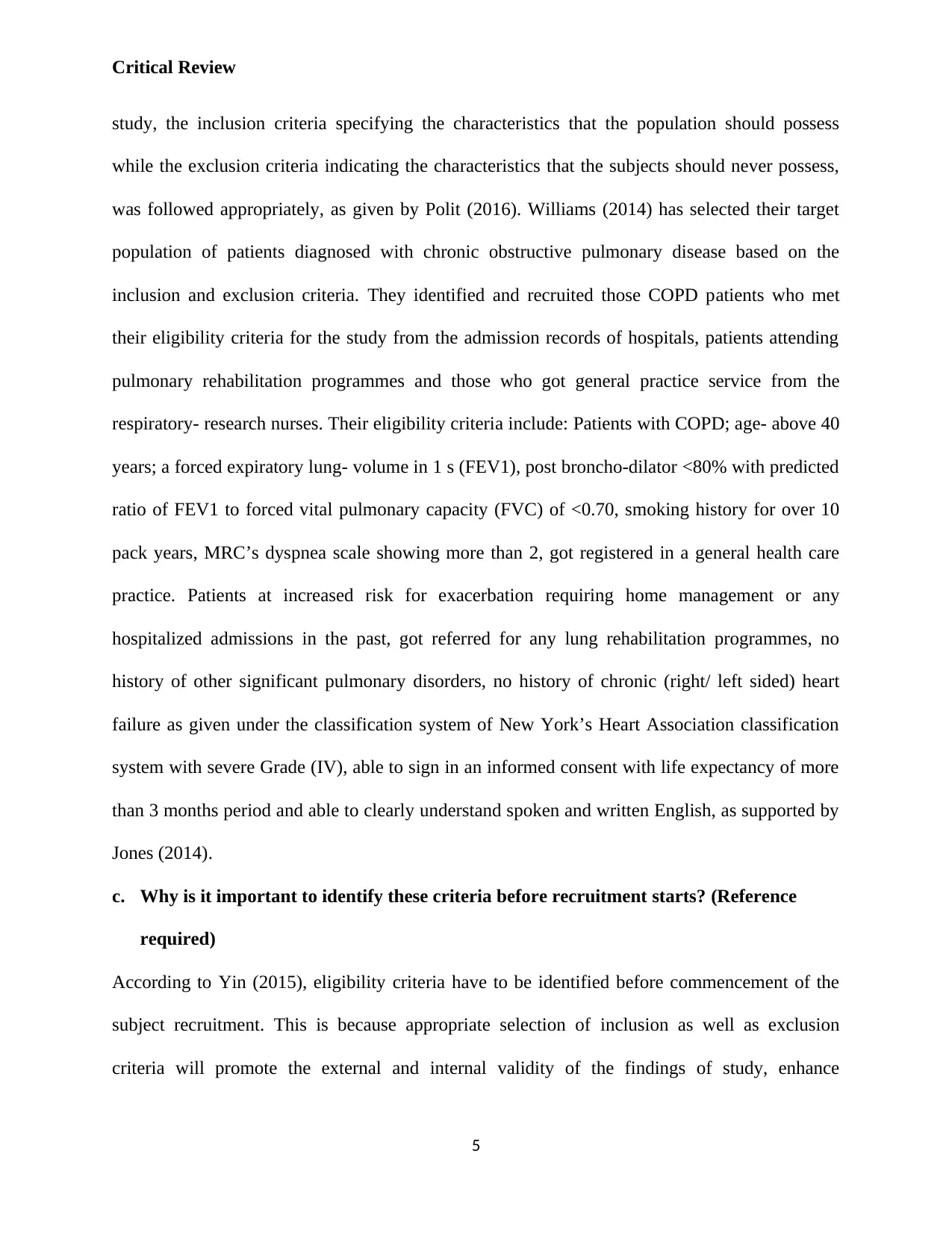
Critical Review
study, the inclusion criteria specifying the characteristics that the population should possess
while the exclusion criteria indicating the characteristics that the subjects should never possess,
was followed appropriately, as given by Polit (2016). Williams (2014) has selected their target
population of patients diagnosed with chronic obstructive pulmonary disease based on the
inclusion and exclusion criteria. They identified and recruited those COPD patients who met
their eligibility criteria for the study from the admission records of hospitals, patients attending
pulmonary rehabilitation programmes and those who got general practice service from the
respiratory- research nurses. Their eligibility criteria include: Patients with COPD; age- above 40
years; a forced expiratory lung- volume in 1 s (FEV1), post broncho-dilator <80% with predicted
ratio of FEV1 to forced vital pulmonary capacity (FVC) of <0.70, smoking history for over 10
pack years, MRC’s dyspnea scale showing more than 2, got registered in a general health care
practice. Patients at increased risk for exacerbation requiring home management or any
hospitalized admissions in the past, got referred for any lung rehabilitation programmes, no
history of other significant pulmonary disorders, no history of chronic (right/ left sided) heart
failure as given under the classification system of New York’s Heart Association classification
system with severe Grade (IV), able to sign in an informed consent with life expectancy of more
than 3 months period and able to clearly understand spoken and written English, as supported by
Jones (2014).
c. Why is it important to identify these criteria before recruitment starts? (Reference
required)
According to Yin (2015), eligibility criteria have to be identified before commencement of the
subject recruitment. This is because appropriate selection of inclusion as well as exclusion
criteria will promote the external and internal validity of the findings of study, enhance
5
study, the inclusion criteria specifying the characteristics that the population should possess
while the exclusion criteria indicating the characteristics that the subjects should never possess,
was followed appropriately, as given by Polit (2016). Williams (2014) has selected their target
population of patients diagnosed with chronic obstructive pulmonary disease based on the
inclusion and exclusion criteria. They identified and recruited those COPD patients who met
their eligibility criteria for the study from the admission records of hospitals, patients attending
pulmonary rehabilitation programmes and those who got general practice service from the
respiratory- research nurses. Their eligibility criteria include: Patients with COPD; age- above 40
years; a forced expiratory lung- volume in 1 s (FEV1), post broncho-dilator <80% with predicted
ratio of FEV1 to forced vital pulmonary capacity (FVC) of <0.70, smoking history for over 10
pack years, MRC’s dyspnea scale showing more than 2, got registered in a general health care
practice. Patients at increased risk for exacerbation requiring home management or any
hospitalized admissions in the past, got referred for any lung rehabilitation programmes, no
history of other significant pulmonary disorders, no history of chronic (right/ left sided) heart
failure as given under the classification system of New York’s Heart Association classification
system with severe Grade (IV), able to sign in an informed consent with life expectancy of more
than 3 months period and able to clearly understand spoken and written English, as supported by
Jones (2014).
c. Why is it important to identify these criteria before recruitment starts? (Reference
required)
According to Yin (2015), eligibility criteria have to be identified before commencement of the
subject recruitment. This is because appropriate selection of inclusion as well as exclusion
criteria will promote the external and internal validity of the findings of study, enhance
5
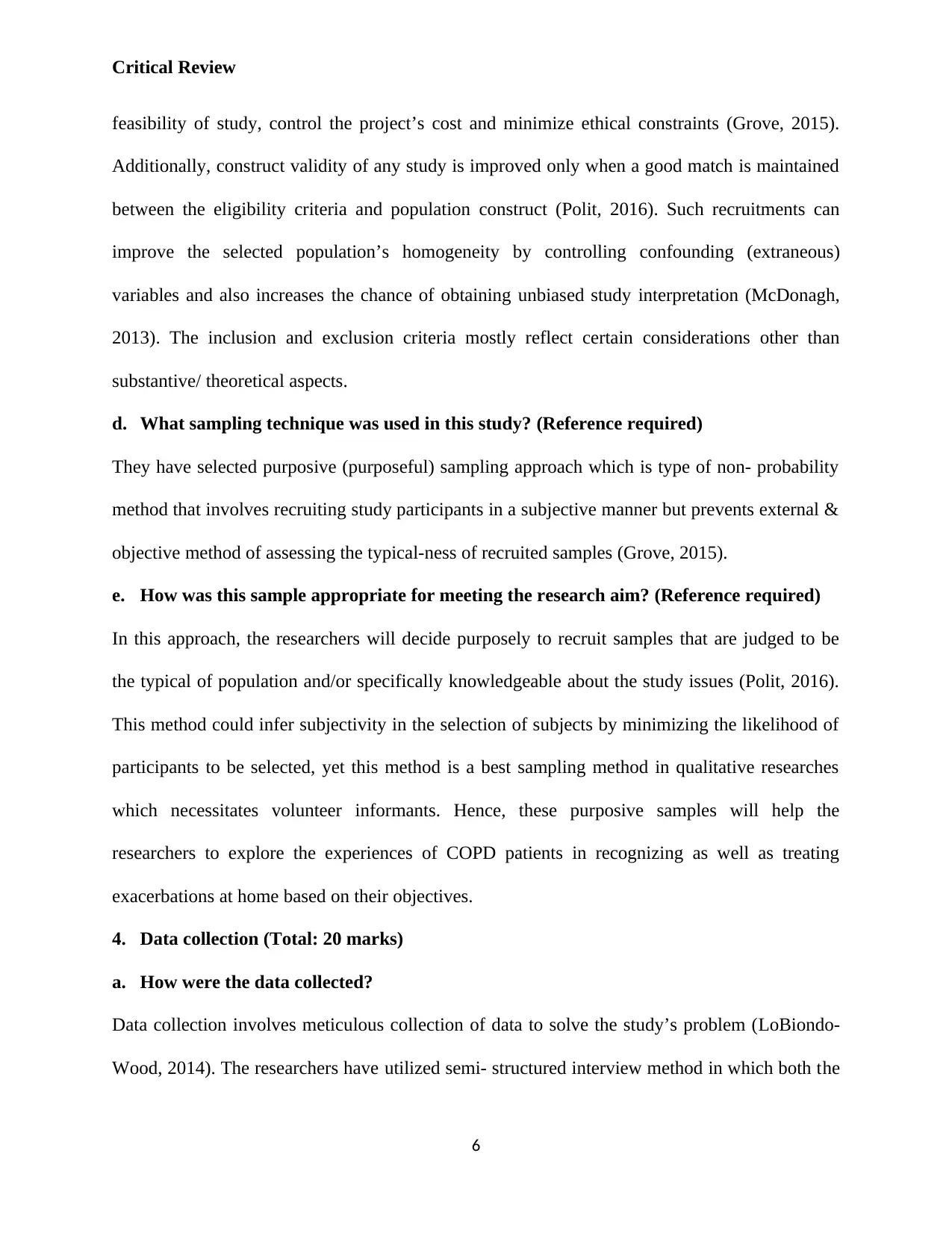
Critical Review
feasibility of study, control the project’s cost and minimize ethical constraints (Grove, 2015).
Additionally, construct validity of any study is improved only when a good match is maintained
between the eligibility criteria and population construct (Polit, 2016). Such recruitments can
improve the selected population’s homogeneity by controlling confounding (extraneous)
variables and also increases the chance of obtaining unbiased study interpretation (McDonagh,
2013). The inclusion and exclusion criteria mostly reflect certain considerations other than
substantive/ theoretical aspects.
d. What sampling technique was used in this study? (Reference required)
They have selected purposive (purposeful) sampling approach which is type of non- probability
method that involves recruiting study participants in a subjective manner but prevents external &
objective method of assessing the typical-ness of recruited samples (Grove, 2015).
e. How was this sample appropriate for meeting the research aim? (Reference required)
In this approach, the researchers will decide purposely to recruit samples that are judged to be
the typical of population and/or specifically knowledgeable about the study issues (Polit, 2016).
This method could infer subjectivity in the selection of subjects by minimizing the likelihood of
participants to be selected, yet this method is a best sampling method in qualitative researches
which necessitates volunteer informants. Hence, these purposive samples will help the
researchers to explore the experiences of COPD patients in recognizing as well as treating
exacerbations at home based on their objectives.
4. Data collection (Total: 20 marks)
a. How were the data collected?
Data collection involves meticulous collection of data to solve the study’s problem (LoBiondo-
Wood, 2014). The researchers have utilized semi- structured interview method in which both the
6
feasibility of study, control the project’s cost and minimize ethical constraints (Grove, 2015).
Additionally, construct validity of any study is improved only when a good match is maintained
between the eligibility criteria and population construct (Polit, 2016). Such recruitments can
improve the selected population’s homogeneity by controlling confounding (extraneous)
variables and also increases the chance of obtaining unbiased study interpretation (McDonagh,
2013). The inclusion and exclusion criteria mostly reflect certain considerations other than
substantive/ theoretical aspects.
d. What sampling technique was used in this study? (Reference required)
They have selected purposive (purposeful) sampling approach which is type of non- probability
method that involves recruiting study participants in a subjective manner but prevents external &
objective method of assessing the typical-ness of recruited samples (Grove, 2015).
e. How was this sample appropriate for meeting the research aim? (Reference required)
In this approach, the researchers will decide purposely to recruit samples that are judged to be
the typical of population and/or specifically knowledgeable about the study issues (Polit, 2016).
This method could infer subjectivity in the selection of subjects by minimizing the likelihood of
participants to be selected, yet this method is a best sampling method in qualitative researches
which necessitates volunteer informants. Hence, these purposive samples will help the
researchers to explore the experiences of COPD patients in recognizing as well as treating
exacerbations at home based on their objectives.
4. Data collection (Total: 20 marks)
a. How were the data collected?
Data collection involves meticulous collection of data to solve the study’s problem (LoBiondo-
Wood, 2014). The researchers have utilized semi- structured interview method in which both the
6
⊘ This is a preview!⊘
Do you want full access?
Subscribe today to unlock all pages.

Trusted by 1+ million students worldwide
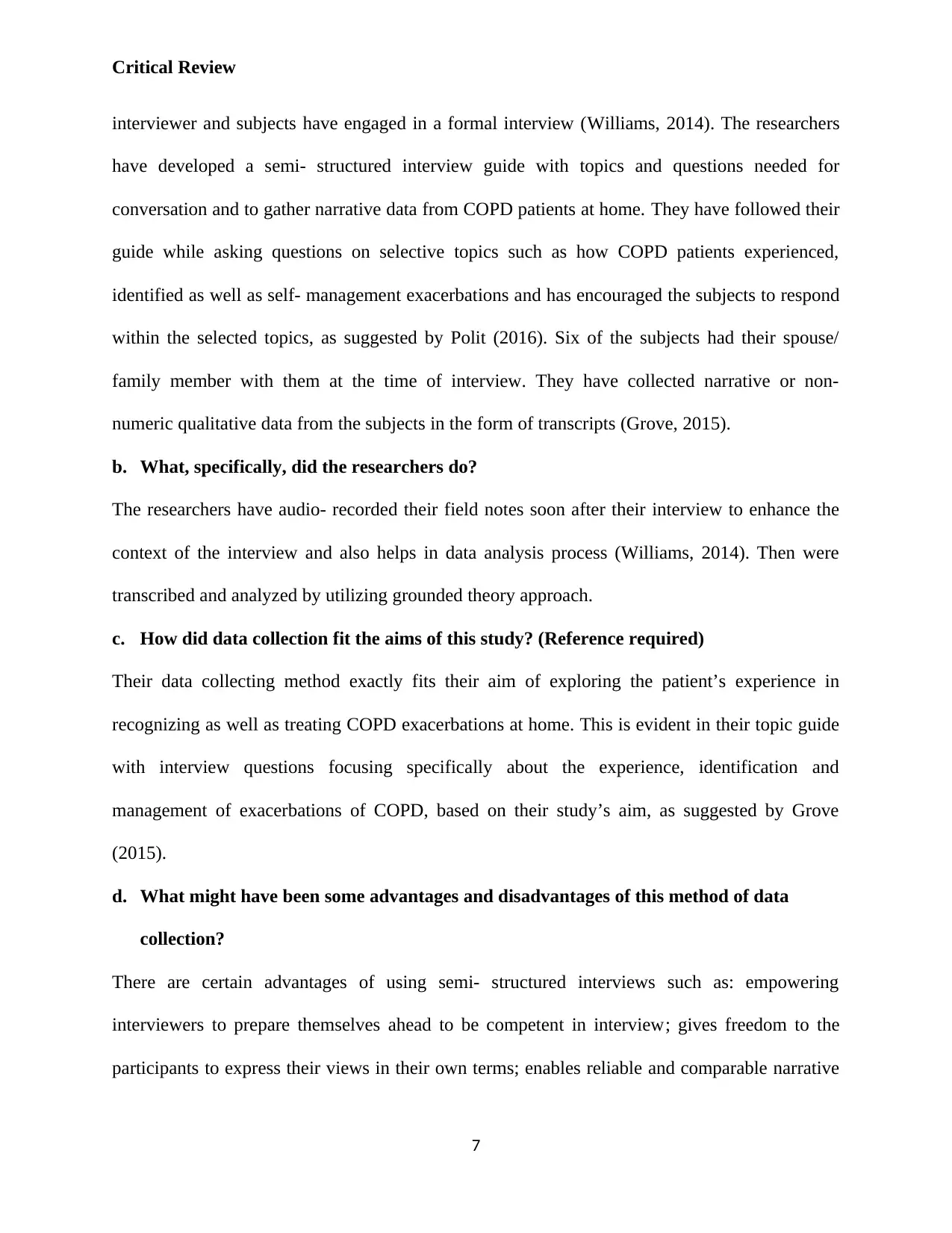
Critical Review
interviewer and subjects have engaged in a formal interview (Williams, 2014). The researchers
have developed a semi- structured interview guide with topics and questions needed for
conversation and to gather narrative data from COPD patients at home. They have followed their
guide while asking questions on selective topics such as how COPD patients experienced,
identified as well as self- management exacerbations and has encouraged the subjects to respond
within the selected topics, as suggested by Polit (2016). Six of the subjects had their spouse/
family member with them at the time of interview. They have collected narrative or non-
numeric qualitative data from the subjects in the form of transcripts (Grove, 2015).
b. What, specifically, did the researchers do?
The researchers have audio- recorded their field notes soon after their interview to enhance the
context of the interview and also helps in data analysis process (Williams, 2014). Then were
transcribed and analyzed by utilizing grounded theory approach.
c. How did data collection fit the aims of this study? (Reference required)
Their data collecting method exactly fits their aim of exploring the patient’s experience in
recognizing as well as treating COPD exacerbations at home. This is evident in their topic guide
with interview questions focusing specifically about the experience, identification and
management of exacerbations of COPD, based on their study’s aim, as suggested by Grove
(2015).
d. What might have been some advantages and disadvantages of this method of data
collection?
There are certain advantages of using semi- structured interviews such as: empowering
interviewers to prepare themselves ahead to be competent in interview; gives freedom to the
participants to express their views in their own terms; enables reliable and comparable narrative
7
interviewer and subjects have engaged in a formal interview (Williams, 2014). The researchers
have developed a semi- structured interview guide with topics and questions needed for
conversation and to gather narrative data from COPD patients at home. They have followed their
guide while asking questions on selective topics such as how COPD patients experienced,
identified as well as self- management exacerbations and has encouraged the subjects to respond
within the selected topics, as suggested by Polit (2016). Six of the subjects had their spouse/
family member with them at the time of interview. They have collected narrative or non-
numeric qualitative data from the subjects in the form of transcripts (Grove, 2015).
b. What, specifically, did the researchers do?
The researchers have audio- recorded their field notes soon after their interview to enhance the
context of the interview and also helps in data analysis process (Williams, 2014). Then were
transcribed and analyzed by utilizing grounded theory approach.
c. How did data collection fit the aims of this study? (Reference required)
Their data collecting method exactly fits their aim of exploring the patient’s experience in
recognizing as well as treating COPD exacerbations at home. This is evident in their topic guide
with interview questions focusing specifically about the experience, identification and
management of exacerbations of COPD, based on their study’s aim, as suggested by Grove
(2015).
d. What might have been some advantages and disadvantages of this method of data
collection?
There are certain advantages of using semi- structured interviews such as: empowering
interviewers to prepare themselves ahead to be competent in interview; gives freedom to the
participants to express their views in their own terms; enables reliable and comparable narrative
7
Paraphrase This Document
Need a fresh take? Get an instant paraphrase of this document with our AI Paraphraser
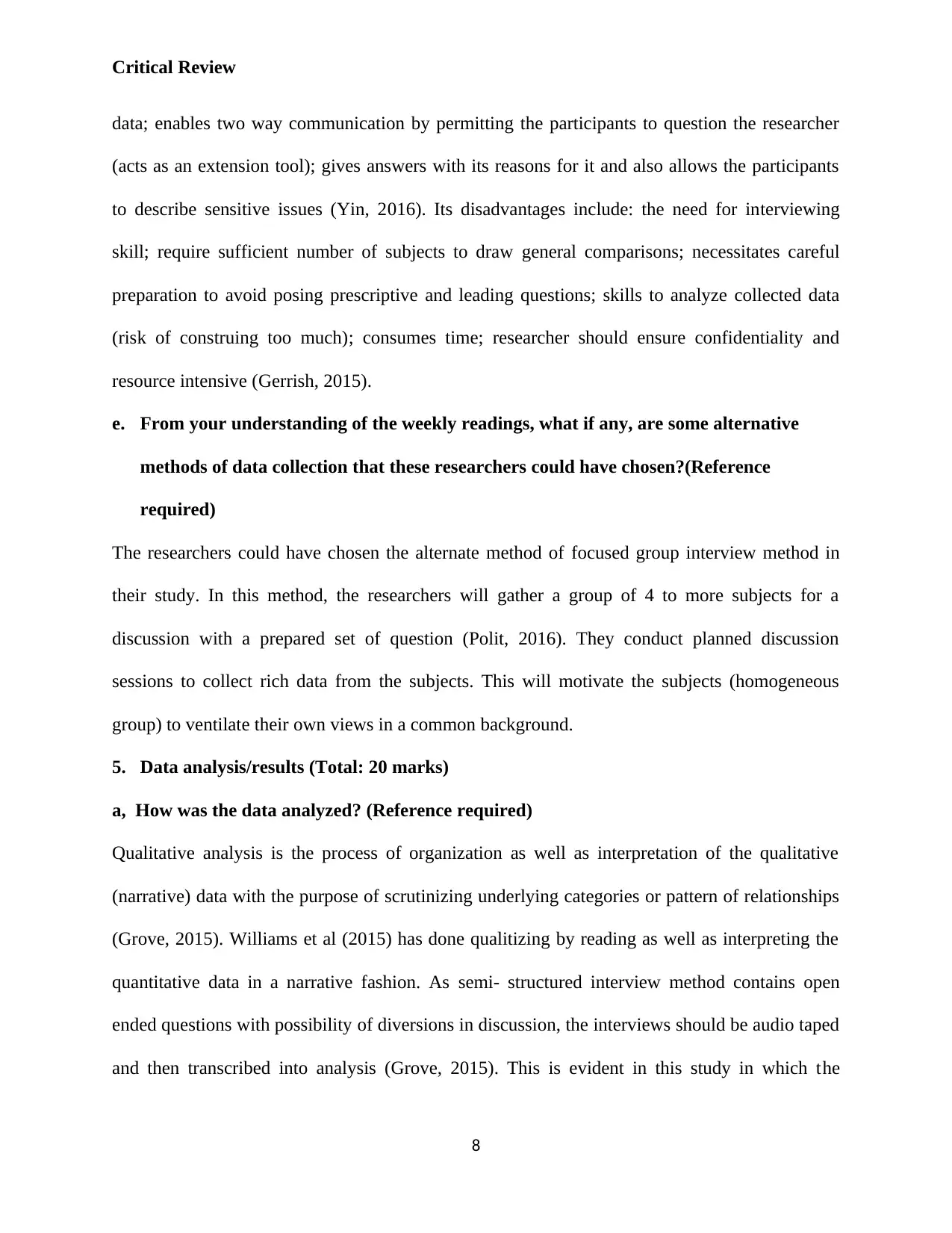
Critical Review
data; enables two way communication by permitting the participants to question the researcher
(acts as an extension tool); gives answers with its reasons for it and also allows the participants
to describe sensitive issues (Yin, 2016). Its disadvantages include: the need for interviewing
skill; require sufficient number of subjects to draw general comparisons; necessitates careful
preparation to avoid posing prescriptive and leading questions; skills to analyze collected data
(risk of construing too much); consumes time; researcher should ensure confidentiality and
resource intensive (Gerrish, 2015).
e. From your understanding of the weekly readings, what if any, are some alternative
methods of data collection that these researchers could have chosen?(Reference
required)
The researchers could have chosen the alternate method of focused group interview method in
their study. In this method, the researchers will gather a group of 4 to more subjects for a
discussion with a prepared set of question (Polit, 2016). They conduct planned discussion
sessions to collect rich data from the subjects. This will motivate the subjects (homogeneous
group) to ventilate their own views in a common background.
5. Data analysis/results (Total: 20 marks)
a, How was the data analyzed? (Reference required)
Qualitative analysis is the process of organization as well as interpretation of the qualitative
(narrative) data with the purpose of scrutinizing underlying categories or pattern of relationships
(Grove, 2015). Williams et al (2015) has done qualitizing by reading as well as interpreting the
quantitative data in a narrative fashion. As semi- structured interview method contains open
ended questions with possibility of diversions in discussion, the interviews should be audio taped
and then transcribed into analysis (Grove, 2015). This is evident in this study in which the
8
data; enables two way communication by permitting the participants to question the researcher
(acts as an extension tool); gives answers with its reasons for it and also allows the participants
to describe sensitive issues (Yin, 2016). Its disadvantages include: the need for interviewing
skill; require sufficient number of subjects to draw general comparisons; necessitates careful
preparation to avoid posing prescriptive and leading questions; skills to analyze collected data
(risk of construing too much); consumes time; researcher should ensure confidentiality and
resource intensive (Gerrish, 2015).
e. From your understanding of the weekly readings, what if any, are some alternative
methods of data collection that these researchers could have chosen?(Reference
required)
The researchers could have chosen the alternate method of focused group interview method in
their study. In this method, the researchers will gather a group of 4 to more subjects for a
discussion with a prepared set of question (Polit, 2016). They conduct planned discussion
sessions to collect rich data from the subjects. This will motivate the subjects (homogeneous
group) to ventilate their own views in a common background.
5. Data analysis/results (Total: 20 marks)
a, How was the data analyzed? (Reference required)
Qualitative analysis is the process of organization as well as interpretation of the qualitative
(narrative) data with the purpose of scrutinizing underlying categories or pattern of relationships
(Grove, 2015). Williams et al (2015) has done qualitizing by reading as well as interpreting the
quantitative data in a narrative fashion. As semi- structured interview method contains open
ended questions with possibility of diversions in discussion, the interviews should be audio taped
and then transcribed into analysis (Grove, 2015). This is evident in this study in which the
8
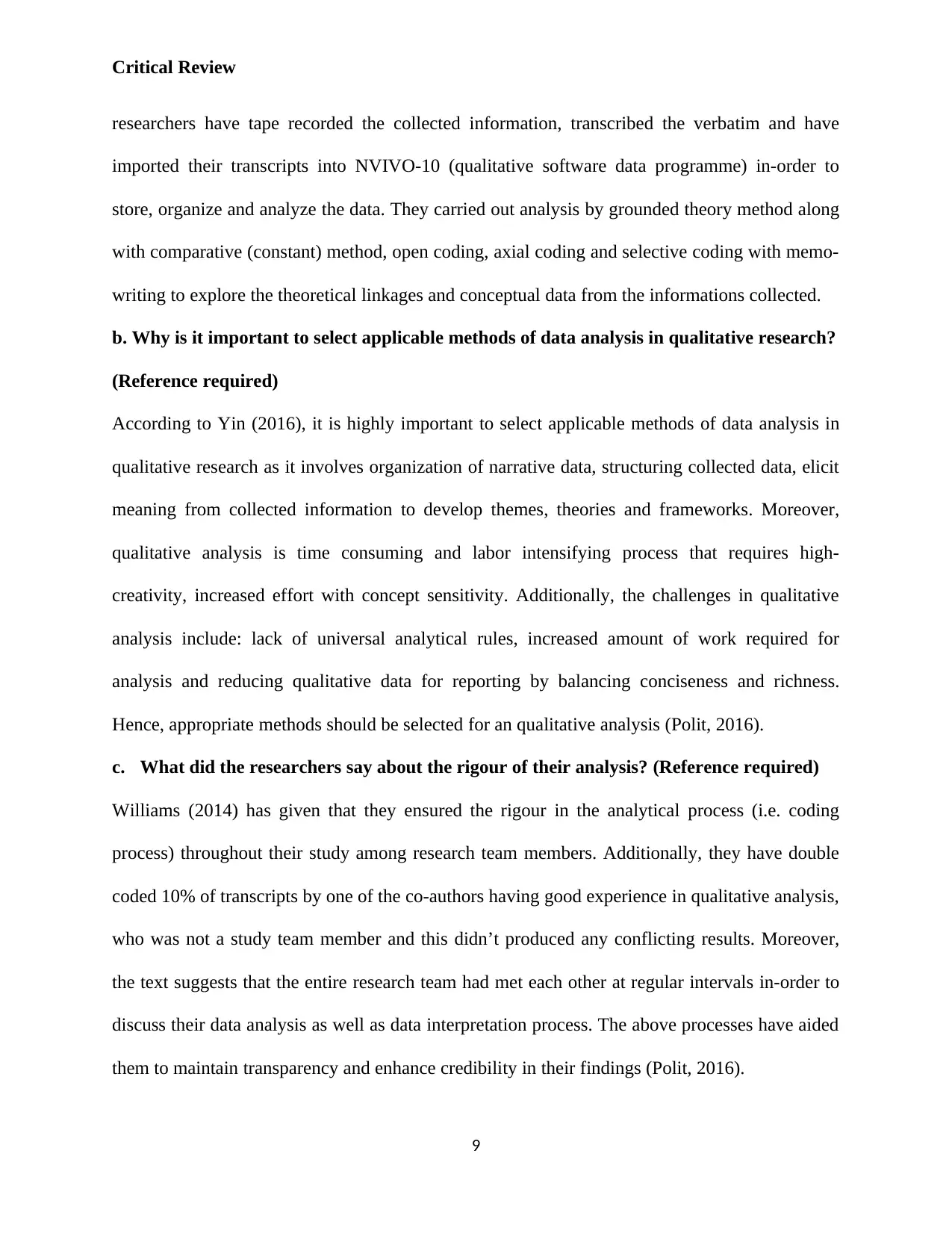
Critical Review
researchers have tape recorded the collected information, transcribed the verbatim and have
imported their transcripts into NVIVO-10 (qualitative software data programme) in-order to
store, organize and analyze the data. They carried out analysis by grounded theory method along
with comparative (constant) method, open coding, axial coding and selective coding with memo-
writing to explore the theoretical linkages and conceptual data from the informations collected.
b. Why is it important to select applicable methods of data analysis in qualitative research?
(Reference required)
According to Yin (2016), it is highly important to select applicable methods of data analysis in
qualitative research as it involves organization of narrative data, structuring collected data, elicit
meaning from collected information to develop themes, theories and frameworks. Moreover,
qualitative analysis is time consuming and labor intensifying process that requires high-
creativity, increased effort with concept sensitivity. Additionally, the challenges in qualitative
analysis include: lack of universal analytical rules, increased amount of work required for
analysis and reducing qualitative data for reporting by balancing conciseness and richness.
Hence, appropriate methods should be selected for an qualitative analysis (Polit, 2016).
c. What did the researchers say about the rigour of their analysis? (Reference required)
Williams (2014) has given that they ensured the rigour in the analytical process (i.e. coding
process) throughout their study among research team members. Additionally, they have double
coded 10% of transcripts by one of the co-authors having good experience in qualitative analysis,
who was not a study team member and this didn’t produced any conflicting results. Moreover,
the text suggests that the entire research team had met each other at regular intervals in-order to
discuss their data analysis as well as data interpretation process. The above processes have aided
them to maintain transparency and enhance credibility in their findings (Polit, 2016).
9
researchers have tape recorded the collected information, transcribed the verbatim and have
imported their transcripts into NVIVO-10 (qualitative software data programme) in-order to
store, organize and analyze the data. They carried out analysis by grounded theory method along
with comparative (constant) method, open coding, axial coding and selective coding with memo-
writing to explore the theoretical linkages and conceptual data from the informations collected.
b. Why is it important to select applicable methods of data analysis in qualitative research?
(Reference required)
According to Yin (2016), it is highly important to select applicable methods of data analysis in
qualitative research as it involves organization of narrative data, structuring collected data, elicit
meaning from collected information to develop themes, theories and frameworks. Moreover,
qualitative analysis is time consuming and labor intensifying process that requires high-
creativity, increased effort with concept sensitivity. Additionally, the challenges in qualitative
analysis include: lack of universal analytical rules, increased amount of work required for
analysis and reducing qualitative data for reporting by balancing conciseness and richness.
Hence, appropriate methods should be selected for an qualitative analysis (Polit, 2016).
c. What did the researchers say about the rigour of their analysis? (Reference required)
Williams (2014) has given that they ensured the rigour in the analytical process (i.e. coding
process) throughout their study among research team members. Additionally, they have double
coded 10% of transcripts by one of the co-authors having good experience in qualitative analysis,
who was not a study team member and this didn’t produced any conflicting results. Moreover,
the text suggests that the entire research team had met each other at regular intervals in-order to
discuss their data analysis as well as data interpretation process. The above processes have aided
them to maintain transparency and enhance credibility in their findings (Polit, 2016).
9
⊘ This is a preview!⊘
Do you want full access?
Subscribe today to unlock all pages.

Trusted by 1+ million students worldwide
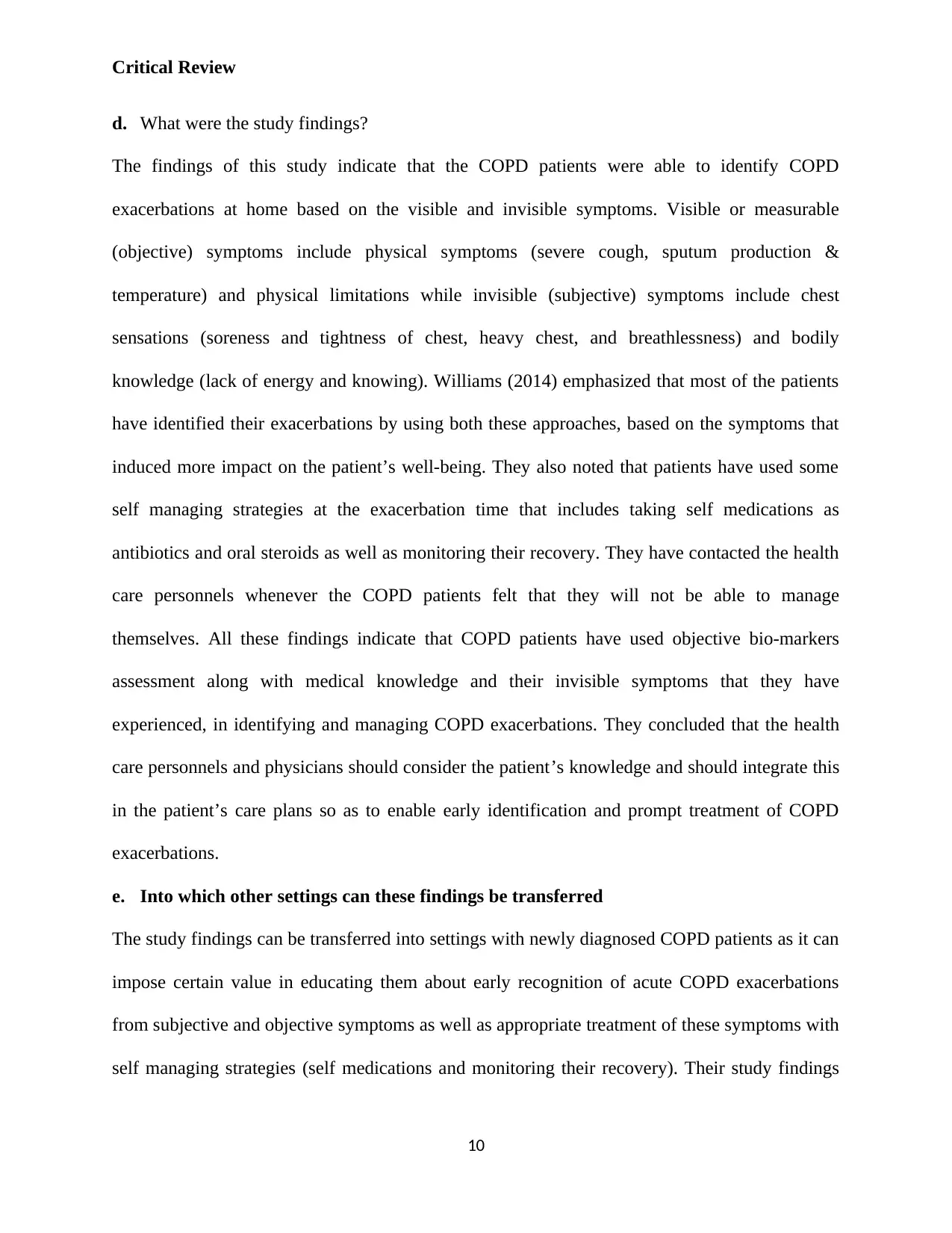
Critical Review
d. What were the study findings?
The findings of this study indicate that the COPD patients were able to identify COPD
exacerbations at home based on the visible and invisible symptoms. Visible or measurable
(objective) symptoms include physical symptoms (severe cough, sputum production &
temperature) and physical limitations while invisible (subjective) symptoms include chest
sensations (soreness and tightness of chest, heavy chest, and breathlessness) and bodily
knowledge (lack of energy and knowing). Williams (2014) emphasized that most of the patients
have identified their exacerbations by using both these approaches, based on the symptoms that
induced more impact on the patient’s well-being. They also noted that patients have used some
self managing strategies at the exacerbation time that includes taking self medications as
antibiotics and oral steroids as well as monitoring their recovery. They have contacted the health
care personnels whenever the COPD patients felt that they will not be able to manage
themselves. All these findings indicate that COPD patients have used objective bio-markers
assessment along with medical knowledge and their invisible symptoms that they have
experienced, in identifying and managing COPD exacerbations. They concluded that the health
care personnels and physicians should consider the patient’s knowledge and should integrate this
in the patient’s care plans so as to enable early identification and prompt treatment of COPD
exacerbations.
e. Into which other settings can these findings be transferred
The study findings can be transferred into settings with newly diagnosed COPD patients as it can
impose certain value in educating them about early recognition of acute COPD exacerbations
from subjective and objective symptoms as well as appropriate treatment of these symptoms with
self managing strategies (self medications and monitoring their recovery). Their study findings
10
d. What were the study findings?
The findings of this study indicate that the COPD patients were able to identify COPD
exacerbations at home based on the visible and invisible symptoms. Visible or measurable
(objective) symptoms include physical symptoms (severe cough, sputum production &
temperature) and physical limitations while invisible (subjective) symptoms include chest
sensations (soreness and tightness of chest, heavy chest, and breathlessness) and bodily
knowledge (lack of energy and knowing). Williams (2014) emphasized that most of the patients
have identified their exacerbations by using both these approaches, based on the symptoms that
induced more impact on the patient’s well-being. They also noted that patients have used some
self managing strategies at the exacerbation time that includes taking self medications as
antibiotics and oral steroids as well as monitoring their recovery. They have contacted the health
care personnels whenever the COPD patients felt that they will not be able to manage
themselves. All these findings indicate that COPD patients have used objective bio-markers
assessment along with medical knowledge and their invisible symptoms that they have
experienced, in identifying and managing COPD exacerbations. They concluded that the health
care personnels and physicians should consider the patient’s knowledge and should integrate this
in the patient’s care plans so as to enable early identification and prompt treatment of COPD
exacerbations.
e. Into which other settings can these findings be transferred
The study findings can be transferred into settings with newly diagnosed COPD patients as it can
impose certain value in educating them about early recognition of acute COPD exacerbations
from subjective and objective symptoms as well as appropriate treatment of these symptoms with
self managing strategies (self medications and monitoring their recovery). Their study findings
10
Paraphrase This Document
Need a fresh take? Get an instant paraphrase of this document with our AI Paraphraser
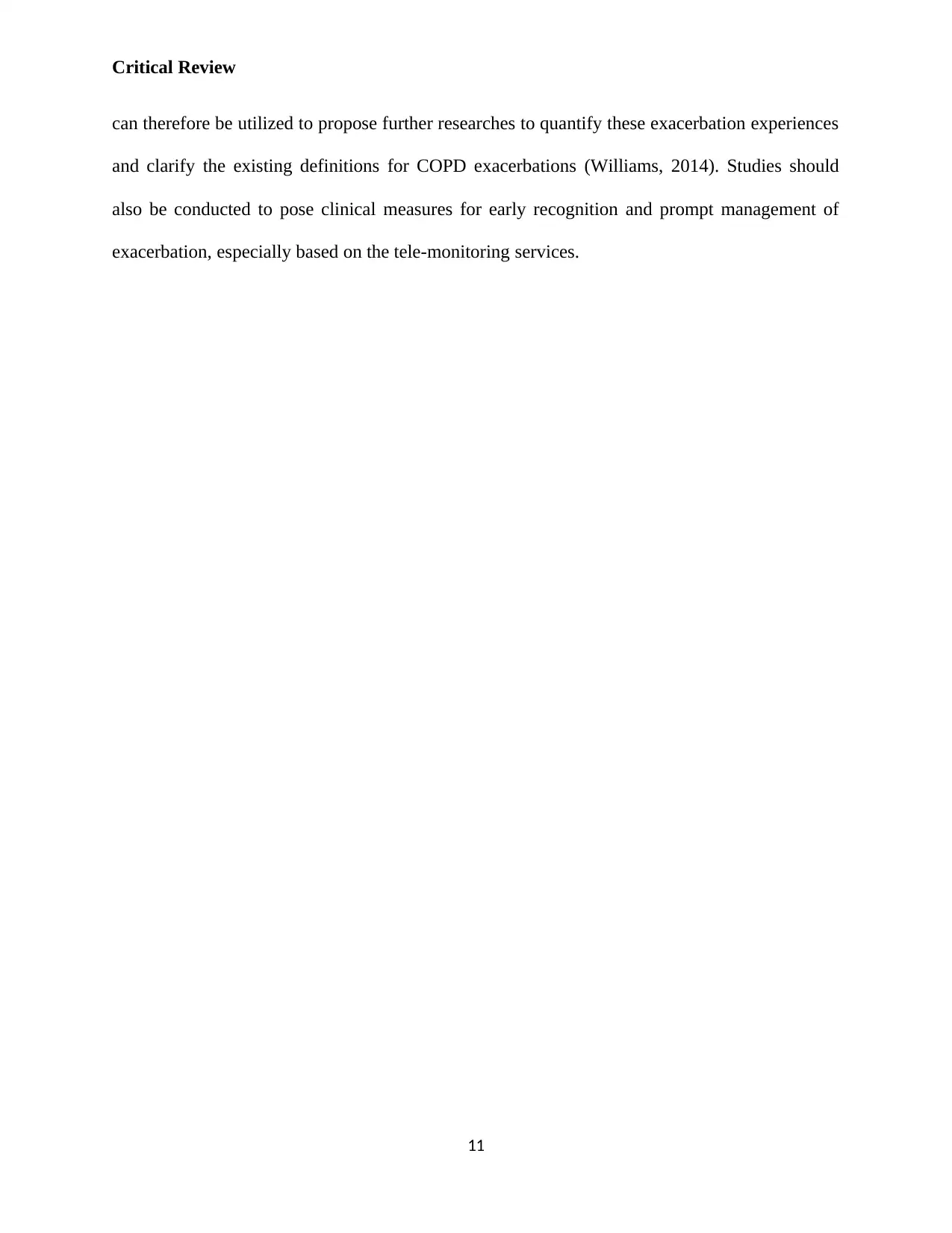
Critical Review
can therefore be utilized to propose further researches to quantify these exacerbation experiences
and clarify the existing definitions for COPD exacerbations (Williams, 2014). Studies should
also be conducted to pose clinical measures for early recognition and prompt management of
exacerbation, especially based on the tele-monitoring services.
11
can therefore be utilized to propose further researches to quantify these exacerbation experiences
and clarify the existing definitions for COPD exacerbations (Williams, 2014). Studies should
also be conducted to pose clinical measures for early recognition and prompt management of
exacerbation, especially based on the tele-monitoring services.
11
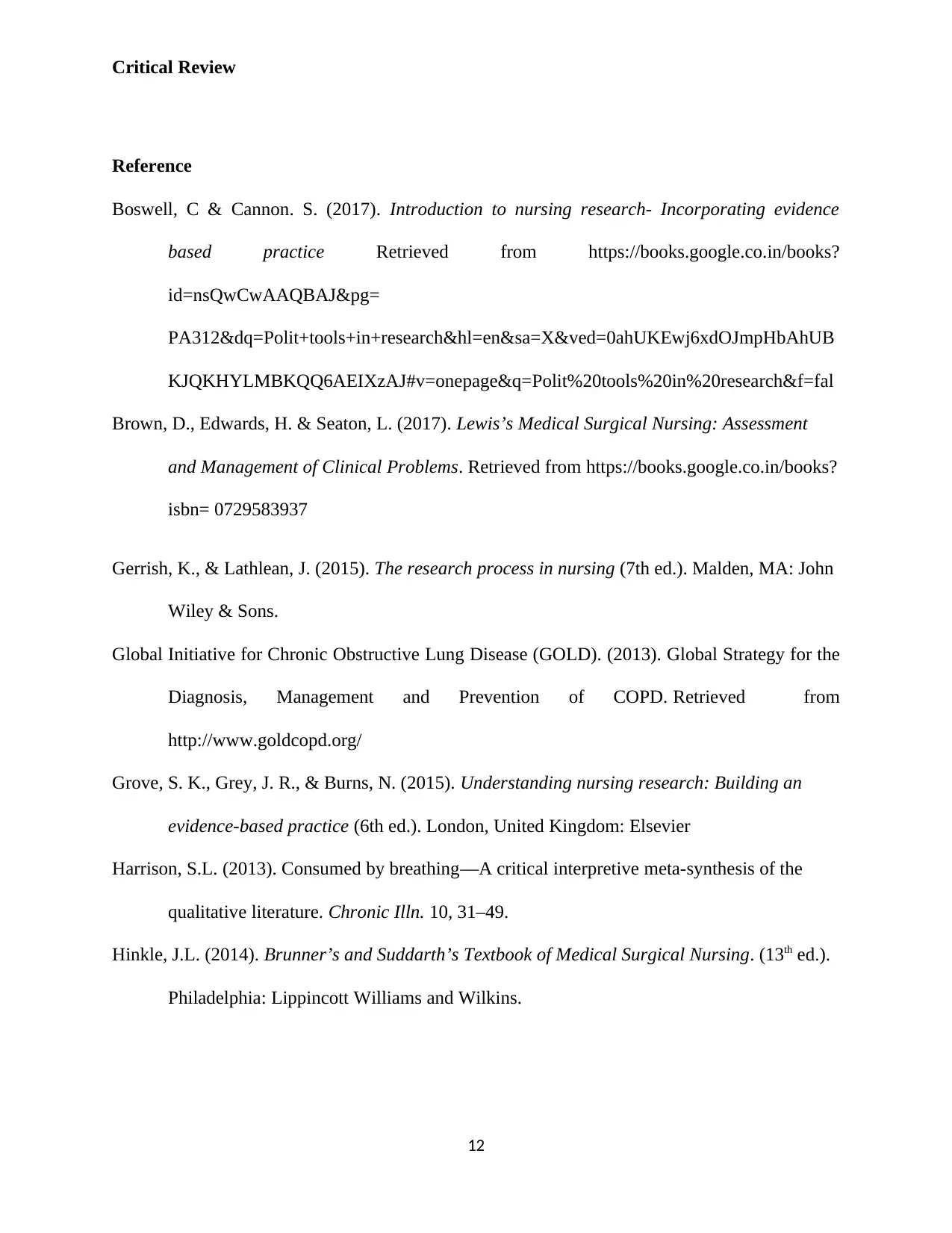
Critical Review
Reference
Boswell, C & Cannon. S. (2017). Introduction to nursing research- Incorporating evidence
based practice Retrieved from https://books.google.co.in/books?
id=nsQwCwAAQBAJ&pg=
PA312&dq=Polit+tools+in+research&hl=en&sa=X&ved=0ahUKEwj6xdOJmpHbAhUB
KJQKHYLMBKQQ6AEIXzAJ#v=onepage&q=Polit%20tools%20in%20research&f=fal
Brown, D., Edwards, H. & Seaton, L. (2017). Lewis’s Medical Surgical Nursing: Assessment
and Management of Clinical Problems. Retrieved from https://books.google.co.in/books?
isbn= 0729583937
Gerrish, K., & Lathlean, J. (2015). The research process in nursing (7th ed.). Malden, MA: John
Wiley & Sons.
Global Initiative for Chronic Obstructive Lung Disease (GOLD). (2013). Global Strategy for the
Diagnosis, Management and Prevention of COPD. Retrieved from
http://www.goldcopd.org/
Grove, S. K., Grey, J. R., & Burns, N. (2015). Understanding nursing research: Building an
evidence-based practice (6th ed.). London, United Kingdom: Elsevier
Harrison, S.L. (2013). Consumed by breathing—A critical interpretive meta-synthesis of the
qualitative literature. Chronic Illn. 10, 31–49.
Hinkle, J.L. (2014). Brunner’s and Suddarth’s Textbook of Medical Surgical Nursing. (13th ed.).
Philadelphia: Lippincott Williams and Wilkins.
12
Reference
Boswell, C & Cannon. S. (2017). Introduction to nursing research- Incorporating evidence
based practice Retrieved from https://books.google.co.in/books?
id=nsQwCwAAQBAJ&pg=
PA312&dq=Polit+tools+in+research&hl=en&sa=X&ved=0ahUKEwj6xdOJmpHbAhUB
KJQKHYLMBKQQ6AEIXzAJ#v=onepage&q=Polit%20tools%20in%20research&f=fal
Brown, D., Edwards, H. & Seaton, L. (2017). Lewis’s Medical Surgical Nursing: Assessment
and Management of Clinical Problems. Retrieved from https://books.google.co.in/books?
isbn= 0729583937
Gerrish, K., & Lathlean, J. (2015). The research process in nursing (7th ed.). Malden, MA: John
Wiley & Sons.
Global Initiative for Chronic Obstructive Lung Disease (GOLD). (2013). Global Strategy for the
Diagnosis, Management and Prevention of COPD. Retrieved from
http://www.goldcopd.org/
Grove, S. K., Grey, J. R., & Burns, N. (2015). Understanding nursing research: Building an
evidence-based practice (6th ed.). London, United Kingdom: Elsevier
Harrison, S.L. (2013). Consumed by breathing—A critical interpretive meta-synthesis of the
qualitative literature. Chronic Illn. 10, 31–49.
Hinkle, J.L. (2014). Brunner’s and Suddarth’s Textbook of Medical Surgical Nursing. (13th ed.).
Philadelphia: Lippincott Williams and Wilkins.
12
⊘ This is a preview!⊘
Do you want full access?
Subscribe today to unlock all pages.

Trusted by 1+ million students worldwide
1 out of 14
Related Documents
Your All-in-One AI-Powered Toolkit for Academic Success.
+13062052269
info@desklib.com
Available 24*7 on WhatsApp / Email
![[object Object]](/_next/static/media/star-bottom.7253800d.svg)
Unlock your academic potential
Copyright © 2020–2025 A2Z Services. All Rights Reserved. Developed and managed by ZUCOL.




